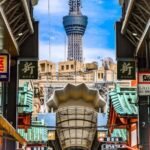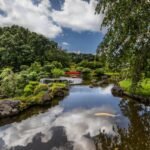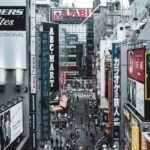Discover the best of Asakusa Tokyo cultural heart — from historic temples and retro amusement parks to must-try street food, rickshaw rides, unique shopping, and two unforgettable festivals. A complete guide for travelers who want the full Japanese experience.
Table of Contents
What kind of place is Asakusa?

Tucked into Tokyo’s Taito Ward, Asakusa is one of the city’s most iconic destinations — not just for tourists, but for anyone wanting to experience “real” Japan. This area is soaked in Edo-period nostalgia: retro alleyways, energetic locals, time-honored temples and shrines, delicious traditional sweets, and food that captures Japan’s culinary soul.
Back in the Edo era, Asakusa thrived as a bustling entertainment district. It was alive with puppet theaters, spinning top shows, and lively red-light quarters. It was also home to theaters for kabuki, opera, and comic storytelling, cementing its place as a hub of Japanese culture. That legacy lives on today in places like the Asakusa Engei Hall, where performers still keep the laughs alive.
These days, the area’s charm has a new neighbor — the Tokyo Skytree, the tallest tower in the world, just a short walk or ride away. So in Asakusa, you get a beautiful collision of old-world atmosphere and futuristic views. Shops line the streets selling fans, chopsticks, and all sorts of crafts — a perfect place to pick up souvenirs that aren’t just things but stories.
When should you visit Asakusa?

It’s great year-round, but if you can swing it, go in May. That’s when the Sanja Matsuri bursts into life. For three days, starting on the third Friday of May, Asakusa throws one of Japan’s biggest and wildest festivals. Expect dancing geisha, portable shrines on parade, and an electric buzz of tradition in the air.
What to wear, season by season:
- Spring (Mar–May): Light jacket, thin sweater
- Summer (Jun–Aug): Breathable clothes, short sleeves
- Autumn (Sep–Nov): Jacket or light coat
- Winter (Dec–Feb): Coat, wool layers, warm knitwear
Getting to Asakusa:
Here’s how long it’ll take from major Tokyo stations to Asakusa Station, your main gateway:
- Tokyo Station: About 20 mins via JR Ueno-Tokyo Line + Metro Ginza Line
- Shinjuku Station: Around 25 mins with a couple of transfers (JR Chuo + Toei Asakusa Line)
- Shibuya Station: About 35 mins straight on the Ginza Line
- Ueno Station: Quickest at just 5 mins on the Ginza Line
- Shinagawa Station: About 25 mins via Keikyu Line + Toei Asakusa Line
Asakusa is slightly away from the hyper-central districts, so budget a little extra time for the ride.
How to get around Asakusa?
Aside from the Tokyo Skytree, everything is pretty walkable. But for a real treat? Hop in a rickshaw. The drivers double as guides, pointing out all the hidden stories while you cruise in style through the streets of Edo-era Tokyo.
To visit Tokyo Skytree, ride the Tobu Skytree Line from Asakusa Station to Tokyo Skytree Station — it’s fast and easy.
Top 18 Must-See Spots in Asakusa
From temples and shrines to parks, museums, and street markets, here are the absolute can’t-miss places that define Asakusa. They’re not just attractions — they’re windows into Japan’s soul.
1. Senso-ji Temple (浅草寺)

This is Asakusa’s crown jewel. Tokyo’s oldest temple, with over 1,300 years of history under its belt, welcomes more than 30 million visitors a year. It’s especially packed during New Year’s visits, bean-throwing ceremonies in February, and other seasonal events.
When you pass through Kaminarimon (Thunder Gate), with its massive red lantern and statues of the wind and thunder gods on either side, you’ll find yourself in Nakamise-dori — a 250-meter stretch lined with snack shops and souvenir stands, all leading you straight to the main hall.
It’s not just a sightseeing spot; it’s an experience. The sound of bells, the scent of incense, the clatter of geta sandals — it all comes together like a timeless soundtrack.
2. Hanayashiki Amusement Park (浅草花やしき)

Right next to the temple, this little amusement park holds a massive legacy. Founded in 1853, it’s Japan’s oldest amusement park, and stepping inside is like time-traveling to a Showa-era dreamland.
You’ll find retro rides like the country’s oldest roller coaster (creaky in the best way), a drop tower called Space Shot, and charming attractions for the little ones like the Mini Ferris Wheel and the iconic Panda Cars.
It’s not about high-tech thrills — it’s all about old-fashioned fun with a side of nostalgia.
3. Ushijima Shrine (牛嶋神社)

A sacred spot founded in the year 860 by the monk Ennin, based on a divine message from the god Susanoo-no-Mikoto. It also enshrines Ame-no-hohi-no-Mikoto and Sada-no-Mikoto, bringing blessings for agriculture, learning, and good relationships.
But the real reason many come here? The Nade-ushi — a life-size bronze cow statue. Stroke it where you have an ache, and it’s said to heal you. There are also “guardian cows” flanking the grounds instead of lions — rare in Japan.
4. Asakusa Shrine (浅草神社)

Tucked just beside Senso-ji’s main hall, this smaller but powerful shrine honors the three men who founded Senso-ji. That’s why locals affectionately call it “Sanja-sama” (Shrine of the Three Deities).
The exact date of founding isn’t known, but it likely dates back to the late Heian or early Kamakura period. Today, it’s the spiritual heart of the Sanja Matsuri, one of Tokyo’s biggest and most intense festivals held every May.
A must-visit if you’re chasing those deeper layers of tradition.
5. Kappabashi Kitchen Street (かっぱ橋道具街)

Between Ueno and Asakusa lies this 800-meter-long shopping street dedicated entirely to food-related tools. If it belongs in a kitchen, it’s probably sold here — from pots and pans to paper lanterns, fake food samples, and chef’s knives.
Around 170 shops line the street, and every October, they throw a “Tool Festival” with crazy deals, prize draws, and mouthwatering food stalls. Whether you’re a pro chef or just obsessed with bento boxes, you’ll want to give yourself time to explore.
6. Tokyo Skytree (東京スカイツリー)

At 634 meters tall, this giant is the tallest tower in the world — and just a short train ride from Asakusa. Two observation decks sit at 350 and 450 meters, offering views that stretch out over Tokyo Bay and even to Mt. Fuji on a clear day.
The Skytree is part of the larger Tokyo Skytree Town, which includes a shopping complex, offices, a planetarium, and the Sumida Aquarium — a full day of sightseeing on its own.
It’s a gleaming contrast to Asakusa’s old-school vibe — past meets future in the skyline.
7. Tokyo Solamachi (東京ソラマチ)

Right at the base of Tokyo Skytree, Solamachi is a full-on shopping and entertainment wonderland with over 300 stores and restaurants. It’s divided into three areas — West Yard, Tower Yard, and East Yard — each with its own vibe.
You’ll find everything from fashion and lifestyle goods to Japanese snacks and souvenirs. It’s also home to the Sumida Aquarium and the Konica Minolta Planetarium “Tenku”, both great picks if you’re with kids or need a break from the sun (or rain).
Even if you don’t shop, it’s fun just to wander. And snack.
8. Sumida Aquarium (すみだ水族館)

This indoor aquarium, located on the 5th and 6th floors of Solamachi’s West Yard, is seriously gorgeous. The tanks are sleek, modern, and spacious, using artificial seawater made in-house — which makes them not only eco-friendly but beautiful to look at.
The vibe here is intimate and immersive. You’ll get up close to penguins, jellyfish, coral reefs, and Tokyo Bay creatures. Their tagline says it all: “The closer you get, the more you love them.”
9. Otori Shrine (鷲神社)

If you’re in Tokyo in November, don’t miss the Tori no Ichi fair here. Otori Shrine is known for this annual event — a good-luck charm marketplace where you buy decorative rakes called kakkome for fortune and business success.
The shrine enshrines Ame-no-hiwashino-mikoto and Yamato Takeru no Mikoto, and it’s said that Yamato Takeru stopped here to give thanks after a victorious battle. The fair now attracts thousands each year, with lanterns glowing, drums beating, and merchants hawking kumade decorated with glitter and charm.
It’s Tokyo tradition with festival magic.
10. Sumida Park (台東区立隅田公園)

Right along the Sumida River, this park is a cherry blossom paradise in spring and a quiet riverfront retreat year-round. It stretches across both banks — one in Taito Ward and the other in Sumida Ward — but the Taito side is the one closer to Asakusa.
Come here for hanami season in late March to early April, when the Sakura Plaza explodes in pink. Or visit any time of year for views of the Skytree peeking out over the water. It’s also a prime picnic spot.
11. Shin-Nakamise Shopping Street (浅草新仲見世商店街)

Dating back to the early Showa period, this covered arcade spans 380 meters, crossing Asakusa east to west. It’s less crowded than Nakamise Street, but just as rich in old-school shops, snack stalls, and quirky boutiques.
What’s lovely here is the roof — it means no matter the weather, you can enjoy browsing. Rain or blazing heat, Shin-Nakamise has you covered — literally.
12. Asakusa Culture and Tourist Information Center (台東区立浅草文化観光センター)

Right across from Kaminarimon, this isn’t just an info spot — it’s an experience. Designed by architect Kengo Kuma, the wooden façade is striking, and inside you’ll find multilingual help desks (Japanese, English, Chinese, Korean), foreign currency exchange, ticket services, and more.
The upper floors feature exhibits on Taito Ward’s culture and events. But the real hidden gem? The free observation deck on the 8th floor. From up there, you get a postcard-perfect view of Kaminarimon and the Tokyo Skytree together.
13. Imado Shrine (今戸神社)

Here’s one for the romantics and lucky charm hunters. Imado Shrine enshrines the divine couple Izanagi and Izanami, considered the first husband and wife in Japanese mythology — making this a hotspot for love and matchmaking.
They even host “Enmusubi” (matchmaking meetups) from time to time, and people come from all over Japan to pray for love. Oh, and fun fact: this shrine is one of the claimed birthplaces of the Maneki-neko (beckoning cat)!
14. Nakamise Shopping Street (浅草仲見世商店街)

Running from Kaminarimon to Senso-ji’s main hall, this is Japan’s oldest shopping street. About 250 meters long, lined with nearly 90 shops, and always buzzing with both tourists and locals.
Souvenirs, street food, traditional crafts, kitschy trinkets — it’s all here. Try some ningyo-yaki (little sponge cakes filled with red bean paste) or fresh senbei (rice crackers), and pick up some fans or chopsticks to take home.
You can feel the centuries of commerce and community in every step.
15. TOKYO CRUISE Water Bus (TOKYO CRUISE 水上バス)

Hop on the Sumida River Line for a breezy cruise that shows you a different Tokyo — from the water. From Asakusa Pier, you’ll pass under 12 bridges including Azumabashi and Kiyosubashi, with views of Skytree and the Asahi Beer Hall.
You can also switch to the Odaiba Line, which heads out toward Tokyo Bay, passing Rainbow Bridge and even a replica Statue of Liberty. It’s a relaxed, photogenic way to travel that feels like a mini-vacation within your trip.
16. Ushijima Shrine (牛嶋神社)

A sacred spot founded in the year 860 by the monk Ennin, based on a divine message from the god Susanoo-no-Mikoto. It also enshrines Ame-no-hohi-no-Mikoto and Sada-no-Mikoto, bringing blessings for agriculture, learning, and good relationships.
But the real reason many come here? The Nade-ushi — a life-size bronze cow statue. Stroke it where you have an ache, and it’s said to heal you. There are also “guardian cows” flanking the grounds instead of lions — rare in Japan.
17. Kimuraya Honten (木村家本店)

Founded in 1868, this is the oldest ningyo-yaki shop in Asakusa. And yes, it’s got the atmosphere of a place that’s seen generations of snack lovers come and go. You’ll find it at the far end of Nakamise-dori, just before the Hozomon gate of Senso-ji.
Their ningyo-yaki — adorable doll-shaped sponge cakes filled with sweet red bean paste — follow the original recipe crafted by the first owner. The batter is made from wheat flour and eggs, and the red bean paste is smooth and not too sweet. The result? Light, fluffy cakes that somehow vanish the second you bite into one (and then you need another).
And since the cakes are shaped like famous Asakusa symbols — like lanterns and the five-story pagoda — they make perfect edible souvenirs.
18. Kamiya Bar (神谷バー)

Say hello to Japan’s first bar, established in 1880, and still standing proudly near Azumabashi Bridge. It’s got history, literary connections, and one heck of a signature drink. Writers like Osamu Dazai and Katai Tayama were known to frequent this spot, and the bar itself shows up in their work.
The building you see today dates back to 1921 and is a registered cultural property. It’s nostalgic in the best way — wooden interiors, etched glass, a mix of locals and tourists soaking up the ambiance.
What should you order? Definitely the house specialty, Denki Bran (literally “electric brandy”). It’s a cocktail invented by the founder, a mysterious mix of brandy, gin, wine, curacao, and herbs. Smooth but strong — and absolutely iconic.
If you want a taste of old Tokyo, this place is it. Drinks, history, atmosphere — all in one.
Must-visit shopping spots in Asakusa
1. Ganso Shokuhin Sample-ya Kappabashi (元祖食品サンプル屋 合羽橋店)

Ever seen those incredibly realistic fake food displays outside Japanese restaurants? Like the sushi that looks more perfect than real sushi? This is where that magic happens.
Right in the heart of Kappabashi Kitchen Town, this shop is run by the legendary Iwasaki Co., a pioneer in food replica art. Originally made for restaurant displays, now these food samples are collector’s items — keychains, magnets, even earrings shaped like ramen, tempura, and parfaits.
Best part? You can try making your own food sample in a workshop. Want to handcraft a lettuce leaf that looks juicier than the real thing? You totally can.
2. Kama Asa Shoten (釜浅商店)

Founded in 1908, this place is a temple for anyone serious about cooking — whether you’re a pro or just love your kitchen. Their philosophy is: “Good tools have a good reason.” And you feel that truth in every product on the shelf.
From carbon-steel knives to finely balanced pans and elegant copper pots, this store is like a love letter to craftsmanship. Everything is handpicked from artisans across Japan, and you’ll often see chefs — from Tokyo and abroad — shopping here.
They even opened a branch in Paris in 2018, bringing Japanese cooking gear to the culinary capital of Europe.
Here, you don’t just buy a tool. You find a lifelong cooking companion.
Asakusa’s two biggest festivals
1. Sanja Matsuri (三社祭)

Held every year on the third weekend of May (Friday to Sunday), Sanja Matsuri is one of Japan’s largest and loudest traditional festivals — and an absolute must-see if your timing’s right.
Centered around Asakusa Shrine, the festival honors the three men who founded Senso-ji Temple (hence “Sanja,” or “three shrines”). For three electric days, nearly two million people pack into Asakusa. It’s sweaty, loud, crowded… and completely unforgettable.
Picture this: groups of locals — some in matching festival gear, some shirtless — hoisting massive mikoshi (portable shrines) through the narrow streets, chanting and bouncing them on their shoulders in a wild, chaotic procession. Traditional music fills the air. Dancers, taiko drummers, geisha, food stalls — it’s Tokyo tradition in hyperdrive.
It’s not just a show — it’s a living, roaring piece of Japanese soul.
More info on the Website
2. Asakusa Samba Carnival Parade Contest (浅草サンバカーニバル パレードコンテスト)

If Sanja Matsuri is the spirit of Edo, then this is Rio de Janeiro in full technicolor. Held on the last Saturday of August, the Asakusa Samba Carnival is Japan’s largest samba competition — and yes, it’s every bit as glittery, rhythmic, and dazzling as it sounds.
More than 5,000 performers from across the country (and some international teams too) flood the streets with incredible costumes, choreographed dances, and enormous allegoria floats. They compete for best performance, and the level of detail and energy is breathtaking.
The whole area turns into a party. Locals cheer from the sidelines, tourists snap photos like mad, and the air vibrates with that infectious Brazilian beat. If you’re lucky enough to be in town, don’t miss it — it’s the most unexpected cultural crossover you’ll find in traditional Asakusa.
More info on the Website
- Asakusa Tokyo Travel Guide: Top Things to Do, See, Eat & Experience in Tokyo’s Most Traditional District (2025)

- Tokyo for Free: 32 Amazing Things to Do Without Spending a Yen (2025)

- 16 Wild Fun Facts About Tokyo That’ll Blow Your Mind (2025)

- Top Things to Do in Shinjuku: Where to Eat, Shop, and Discover Tokyo’s Urban Jungle (2025)

- Best Things to Do in Shibuya: Where to Eat, Shop, and Explore in Tokyo’s Trendiest District (2025)

